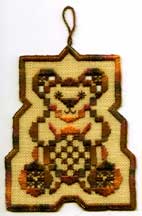Note: For finer details of Hardanger, refer to Hardanger,
self-published by Marion Scoular at $8.50 plus $1.50 for shipping
and handling. Georgia residents, please add $.50 sales tax.
Introduction
The word Kloster comes from the same "root" as cloister,
meaning "an enclosure." Kloster means block, so Kloster
blocks is incorrect. It should be Kloster or block!
If you are stitching the blocks in a clockwise direction around
the shape, ALWAYS stitch from the inside of the shape to the
outside and you will never have an incorrect wrong side stitch.
This can be crucial because of the cutting and withdrawal of
the fabric threads later.
However...
To manipulate the placement of colors with Watercolours threads,
this guideline will be broken. Half the thread will be stitched
in a clockwise direction, the other half counter-clockwise. To
ensure a correct wrong side (important because we want this piece
to be reversible), the second half will be stitched from the
outside of the shape to the inside.
Note: In manipulating color placement with over-dyed threads,
you may actually throw some away. I know...that hurts!
Manipulating Burnt Toast
Open up the skein of Watercolours but DO NOT CUT IT. Lay it
in a circle on a table, unwrap until you find a yellow area.
From the middle of this, measure out 32" both ways. This
means that the first yellow area may not be right. Cut, making
a 64" long thread. Separate gently into three individual
threads.
Measure, to find the center of your congress cloth, and, with
a needle,"wiggle" a hole to mark it. This is your starting
point.
Thread one end of your long thread into a #22 tapestry needle.
Hold the exact center of the yellow area between your left thumb
and forefinger. Insert the needle at # 1 in Diagram 1. Pull through
until the part you are holding stops at "X." This will
center your color.
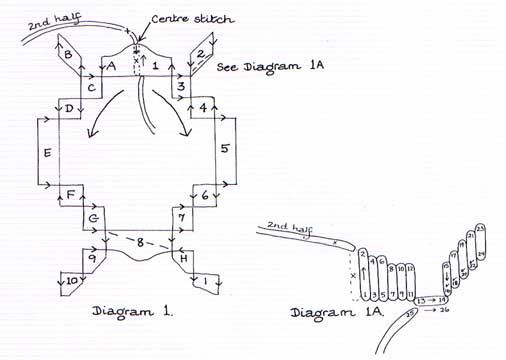
Diagram 1 and Diagram 1a
Following the arrows and block numbers, stitch the first half
thread clockwise, having "parked" the other half out
of the way. When you reach the last stitch of block # 1, refer
to Diagram 1a for the sequence to negotiate blocks # 2 and #
3.
When block # 10 is completed, secure the thread on the wrong
side through blocks # 10, then # 9, then # 8.
Now thread the second half into your # 22 tapestry needle and
stitch a mirror-image, working from the outside to the inside,
following A to I. To go from G to H, travel through the back
of 8.
The second motif the head will be stitched using
the same concept, starting in the middle at the chin. Be sure
to note the sequence at the ears in Diagram 2.

Diagram 2
On finishing block 10, secure the thread on the wrong side
through blocks 10, 9, 8 and 7.
Follow the letters for the second half of the thread, getting
from block J to K by going through the wrong side of J and I.
To stitch the feet, cut the third long thread in half and stitch
from the inside to the outside as shown in Diagram # 3, placing
the yellow where you wish. Mirror image the other foot.
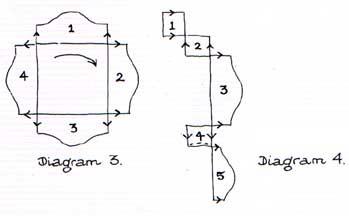
Diagram 3 and Diagram 4
The left and right side will also be stitched as indicated
by the arrows - mirror-imaging the color placement.
Cutting and Withdrawing Threads
For the feet and ears, cut only four threads where
indicated by the wavy lines. Withdraw those threads.
Weaving
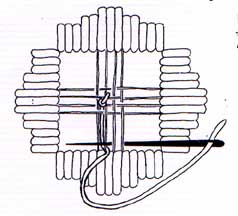
Diagram 1
Using the # 8 Pearl cotton and a # 24 tapestry needle, put
a knot off-center in the center square of fabric.
Bring the needle up at the lower edge, between the four threads
as shown in Diagram 1. You will need to hold the thread on the
wrong side to the left until Diagram 1 and 2 have been executed.
The thread from the knot to the beginning will be secured by
subsequent stitches.
Pull these stitches TIGHTLY. The idea is to produce a lace-like
effect by making the holes larger.
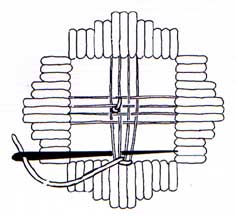
Diagram 2
Continue weaving in a figure of eight (alternating Diagrams
1 and 2) until you have filled the bar.

Diagram 3 and 4
Stop when the thread is leaning in the direction of the next
bar to be worked. Come up between the four threads of the next
bar and stop when half-woven, with the thread facing the hole
in which the Dove's Eye filet is to be worked.
Be Sure to Come
Back for Part II next month!
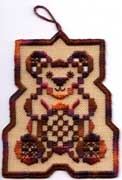
About Marion
Marion Scoular was born in Palestine of
British / American parents. She graduated from the Royal School
of Needlework in 1955, with a 3-year Mark Excellent Diploma.
At the time, Marion was the youngest student to receive the First
Place Award from the Worshipful Company of Needlemakers and also
the First Prize Silver Medal from the City and Guilds of London.
After one year at a Cambridge Institute College, Marion taught
Dressmaking in English High Schools for 3 years.
Upon emigrating to the U.S., Marion opened
The Robin Hood Wool Shop in Clemson, SC and ran it for 13 years.
She concurrently taught Adult Education classes at Clemson University.
Marion has authored many correspondence courses, the first of
which was offered by the EGA in 1970. Her current courses include
Blackwork and Pulled Stitches, offered by the ANG, and Hardanger
and Finishing with Flair, offered by the EGA. She has taught
workshops, given lectures and judged in 40 states (with hopes
to eventually include all 50!), Canada, Mexico and Australia.
Further impeccable credentials include: teaching the Counted
Thread Shopowner's Certification Program, being on the faculty
of Callaway Gardens Needlecraft School, The Valentine Assembly
(now the National Academy of Needlearts), the Council of American
Embroiderers, the Smocking Arts Guild of America and the National
Embroidery Teacher's Association. Marion also co-coordinated
the Pinehurst Institute of Advanced Needleart and teaches at
Trade shows for Wichelt Imports, Inc.
In addition to the above, Marion has contributed
articles to numerous publications, has been featured on TV and
has made a video on Basic Canvas Embroidery. Another vocation
is leading embroidery tours abroad.
With all this on her plate, one would hardly
think that Marion could have time for other leisure activities.
But she does and they include sports car rallying, gymkhanas,
square dancing, international folk dancing, singing, reading,
listening to audio books (great, while stitching), concerts and
theater going.
And now, Marion has written a book. One,
which, not only tells you how to, but also, why. Entitled Advice
is for Listening to - not Necessarily Taking!!, Marion's
book covers starts, joins and endings in Canvas, Cross Stitch,
Hardanger, Blackwork, Pulled Stitches, Surface Stitchery and
much, much more to improve the techniques you enjoy and to broaden
your knowledge of others. It is packed full of tips and ideas
- and peppered with Words of Wisdom...In sharing her "two
cents" worth, Marion acknowledges that what you do with
it, is up to you. Marion says of her book, "In sharing some
of the many tips and ideas gleaned from over 45 years of teaching
the art of the needle, I acknowledge your right to disagree with
me...hence the title...It was one of my Scottish father's many
phrases of wisdom...It is never too late to learn or adapt. My
mother, Marjorie Reid, started taking my evening classes at the
age of 60 and contributed several of the concepts...at age 65,
she came to work at my shop - The Robin Hood Wool Shop - and
at 71, she bought the shop from me, operating it until her death
five years later."
Advice is for Listening to - not Necessarily
Taking!! is available directly from Marion for $26.00,
plus $4.00 for shipping and handling. Georgia residents, please
add $1.56 sales tax. Also available from Marion is her self-published
booklet, Hardanger, for $8.50 plus $1.50 for shipping
and handling. Georgia residents, please add $.50 sales tax. Please
be patient when ordering as Marion is a strictly one-woman operation!
For more information, or to order a copy of Marion Scoular's
book, contact her at:
Sherwood Studio
2840 Skye Terrace
Duluth, GA 30096-6262
Phone and Fax : (770) 497- 0648
E mail: marionscoular@email.msn.com


